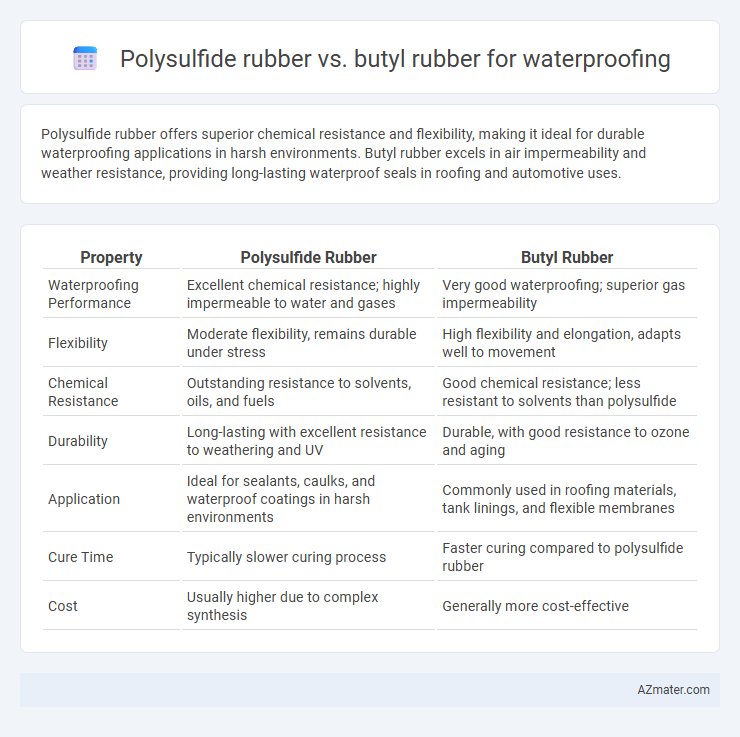Polysulfide rubber offers superior chemical resistance and flexibility, making it ideal for durable waterproofing applications in harsh environments. Butyl rubber excels in air impermeability and weather resistance, providing long-lasting waterproof seals in roofing and automotive uses.
Table of Comparison
| Property | Polysulfide Rubber | Butyl Rubber |
|---|---|---|
| Waterproofing Performance | Excellent chemical resistance; highly impermeable to water and gases | Very good waterproofing; superior gas impermeability |
| Flexibility | Moderate flexibility, remains durable under stress | High flexibility and elongation, adapts well to movement |
| Chemical Resistance | Outstanding resistance to solvents, oils, and fuels | Good chemical resistance; less resistant to solvents than polysulfide |
| Durability | Long-lasting with excellent resistance to weathering and UV | Durable, with good resistance to ozone and aging |
| Application | Ideal for sealants, caulks, and waterproof coatings in harsh environments | Commonly used in roofing materials, tank linings, and flexible membranes |
| Cure Time | Typically slower curing process | Faster curing compared to polysulfide rubber |
| Cost | Usually higher due to complex synthesis | Generally more cost-effective |
Introduction to Polysulfide and Butyl Rubber
Polysulfide rubber, known for its excellent chemical resistance and flexibility, is widely used in waterproofing applications due to its strong adhesion and durability against water and solvents. Butyl rubber, characterized by its low permeability and high impermeability to gases, provides superior waterproofing performance in environments requiring airtight seals and resistance to moisture ingress. Both materials offer distinct advantages in waterproofing: polysulfide rubber excels in flexibility and chemical resistance, while butyl rubber is preferred for its exceptional impermeability and long-term weather resistance.
Chemical Structure and Composition
Polysulfide rubber consists of long chains with sulfur-sulfur bonds that provide excellent chemical resistance and flexibility, making it highly effective for waterproofing applications. Butyl rubber, composed mainly of isobutylene with a small amount of isoprene, offers low permeability to gases and moisture due to its dense, saturated structure. The chemical composition of polysulfide rubber allows better solvent resistance, while butyl rubber excels in impermeability and durability under harsh environmental conditions.
Waterproofing Performance Comparison
Polysulfide rubber exhibits superior waterproofing performance due to its excellent chemical resistance and flexibility, making it ideal for environments exposed to solvents, oils, and water. Butyl rubber offers outstanding impermeability to gases and moisture, providing strong waterproofing properties but with less chemical resistance than polysulfide. The choice depends on specific application conditions, with polysulfide preferred for harsh chemical exposure and butyl rubber favored for long-term moisture barrier needs.
Durability and Longevity
Polysulfide rubber offers superior chemical resistance and flexibility, making it highly durable for waterproofing applications exposed to harsh environmental conditions. Butyl rubber provides excellent impermeability to gases and moisture, ensuring long-lasting waterproof seals with outstanding resistance to aging and weathering. Both materials demonstrate significant longevity, but polysulfide rubber excels in mechanical durability, while butyl rubber is preferred for sustained moisture barrier performance.
Flexibility and Elasticity
Polysulfide rubber exhibits superior flexibility and elasticity compared to butyl rubber, making it highly effective for waterproofing applications that require durable movement accommodation. Its molecular structure allows greater elongation and recovery, ensuring long-term performance in sealing joints exposed to dynamic stress. Butyl rubber, while offering excellent impermeability, has lower elasticity and can become brittle under extreme temperature variations, limiting its use in highly flexible waterproofing scenarios.
Application Methods and Ease of Use
Polysulfide rubber offers superior flexibility and adhesion, commonly applied via brush, trowel, or spray for sealing expansion joints and marine structures, requiring skilled handling due to its curing process. Butyl rubber, known for its excellent waterproofing and chemical resistance, is often applied as pre-formed sheets or tapes, simplifying installation with minimal surface preparation and faster curing times. Both materials provide durable waterproofing, but butyl rubber's ease of use and faster application make it ideal for quick repairs, while polysulfide rubber suits complex, high-performance sealing tasks.
Resistance to Environmental Factors
Polysulfide rubber exhibits superior resistance to chemicals, UV radiation, ozone, and extreme temperature fluctuations, making it highly effective for long-term waterproofing applications in harsh environmental conditions. Butyl rubber also offers excellent impermeability and moisture resistance but tends to degrade faster under prolonged UV exposure and ozone contact. For projects requiring enhanced durability against environmental factors, polysulfide rubber provides a more resilient waterproofing solution.
Cost Analysis: Polysulfide vs Butyl Rubber
Polysulfide rubber generally incurs higher initial costs compared to butyl rubber due to its complex manufacturing process and superior chemical resistance. Butyl rubber offers a more cost-effective solution for waterproofing, with lower raw material expenses and simpler curing requirements, making it suitable for budget-sensitive projects. Despite higher upfront prices, polysulfide rubber's durability and flexibility often result in reduced maintenance costs over time, potentially offsetting the initial investment.
Typical Uses in Construction and Industry
Polysulfide rubber is widely used for waterproofing joints in construction due to its excellent chemical resistance and flexibility, making it ideal for sealing expansion joints, roofs, and water tanks. Butyl rubber excels in industrial waterproofing applications thanks to its superior impermeability and durability, often applied in roofing membranes, pond liners, and protective coatings. Both materials offer reliable waterproofing solutions, with polysulfide favored for dynamic joints and butyl for static barriers.
Pros and Cons Summary for Waterproofing Choices
Polysulfide rubber offers excellent chemical resistance and flexibility, making it ideal for durable waterproof sealing in harsh environments, but it is more expensive and has a longer curing time compared to Butyl rubber. Butyl rubber provides superior air and moisture impermeability with outstanding self-healing properties, making it cost-effective and easier to apply, although it has lower resistance to solvents and UV exposure. Choosing between Polysulfide and Butyl rubber depends on specific project requirements, balancing chemical resistance, flexibility, application conditions, and budget constraints.

Infographic: Polysulfide rubber vs Butyl rubber for Waterproofing
 azmater.com
azmater.com